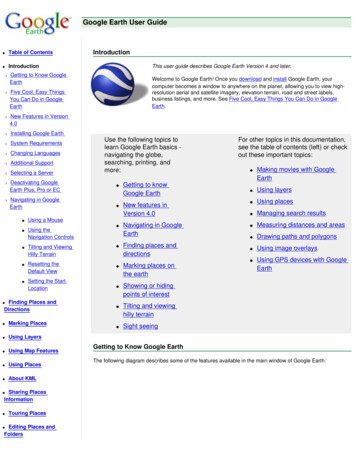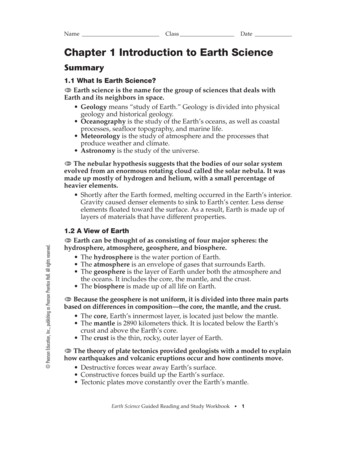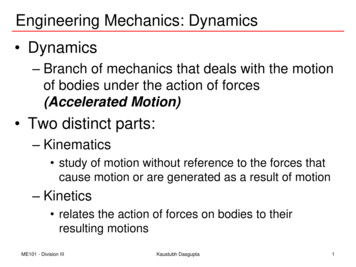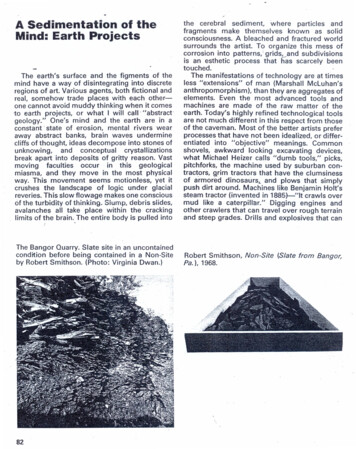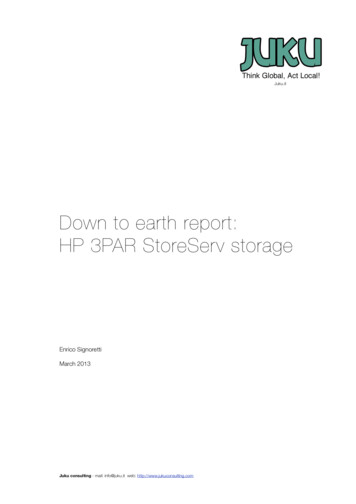
Transcription
Juku.itDown to earth report:HP 3PAR StoreServ storageEnrico SignorettiMarch 2013Juku consulting - mail: info@juku.it web: http://www.jukuconsulting.com
Jukuconsulting.comIndexExecutive summary3Introduction4A brief history4The product family5Architecture7A brief introduction7Controller Node8Why it is important for you9The ASIC10What is an ASIC?10How it is implemented by 3PAR StoreServ10Why it is important for you10Software12What is software?12How it is implemented by 3PAR StoreServ12Why it is important for you13Wide striping14What is wide striping?14How it implemented by 3PAR14Why it is important for you15Thin provisioning16What is thin provisioning?16How it is implemented by 3PAR StoreServ16Why it is important for you17Snapshots18What is a snapshot?18How it is implemented by 3PAR StoreServ18Why it is important for you19Multi tenancy20What is multi tenancy?20 2013, Juku consulting srl. All rights reserved
Jukuconsulting.comHow it is implemented by 3PAR StoreServ20Why it is important for you21Automation22What is automation?22How it is implemented by 3PAR StoreServ22Why it is important for you23Replication24What is data replication?24How it is implemented by 3PAR StoreServ24Why it is important for you25Storage federation26What is storage federation?26How it is implemented by 3PAR StoreServ26Why it is important for you27Integration28What is integration?28How it is implemented by 3PAR StoreServ28Why it is important for you29Bottom line30Juku31Why Juku31Author31 2013, Juku consulting srl. All rights reserved
Jukuconsulting.com3Executive summaryNowadays, where business runs at internet speed, many companies arelooking at new ways to store and manage tier 1 data, especially from theefficiency and automation standpoints. Databases and core applicationstransactions need to be processed as fast as possible while integration withhypervisors and ease of management are the base of day-to-day work.Ordinary storage technology is no longer enough to sustain high demandingrequirements at a reasonable cost, particularly when we speak in terms ofROI and TCO (total cost of ownership). Next generation architectures andtechnology are the only way to achieve the best of the breed in performanceand efficiency.Many vendors are working on new solutions to address customers’requests. Actually, the “enterprise storage” market is quite segmented andaddressing many different targets: it ranges from commodity hardwarestorage to pure flash systems. At the same time the DNA of disk arrays isquite different too: some products adopt 100% commodity hardware whileimproving the capabilities of traditional solutions via software, others developno-compromise architectures for achieving the best in terms of performanceand efficiency. And of course, in the middle there are a lot of nuances.Maturity in these kind of products is another important key factor. In fact,enterprises are looking at performance but, at the same time, reliability andavailability are fundamental to run 7x24 businesses without disruptions.Eventually, the initial investment to acquire a next generation storage solutionis easy to absorb due to the impact of the increase of overall performanceand diminished management efforts that can positively affect all the businessprocesses.HP 3PAR StoreServ Storage systems are to be considered top of the notchin next generation enterprise Tier 1 arrays, with well implemented featuresand very high overall efficiency. With the introduction of HP 3PAR StoreServ7000, The HP 3PAR StoreServ family can also be adopted by any kind ofend user ranging from large enterprises to SMBs. 2013, Juku consulting srl. All rights reserved
Jukuconsulting.com4IntroductionA brief historyThe HP 3PAR StoreServ product family comes from an acquisition that HPmade in 2010. 3PAR was originally founded in 1999 by Jeffrey Price, AshokSinghal and a third partner, Robert Rogers, who left the company a coupleyears later. The P,A and R in the name come from the initials of the founders.The mission of the company was “to make storage solutions simple andefficient".The first product, called “InServ storageserver”, was shipped in 2002 and thec o m p a n y re l e a s e d i t s fi r s t t h i nprovisioning implementation in 2003. Infact, the company was widely recognized as a pioneer in thin provisioningand other efficiency techniques that we now find in many other storagesystems. 3PAR’s primary competitors where EMC, HDS and IBM.3PAR went through an initial public offering in 2007 and was listed on NYSE.After the acquisition of 3PAR, HP decided to move some 3PAR key figures tooccupy important management roles in HP’s storage division. The mostvisible one was David Scott, former 3PAR CEO and president, who now is incharge of the overall enterprise storage division. Scott has been working onthe new HP storage strategy and rationalization of the offering after theacquisitions that his new company made during the past years. 3PARStoreServ, as the product is know known at HP, has a flagship role in thisstrategy but it’s clear that the company will also continue to develop otherimportant assets of its portfolio like: StoreVirtual (P4000) SMB storage,StoreOnce backup solutions and the recently announced StoreAll (Objectstorage) family of products. 2013, Juku consulting srl. All rights reserved
Jukuconsulting.com5The product familyThe HP 3Par StoreServ family of productsis comprised of two models: 7000 and10000. The first one is aimed ataddressing midrange deployments whilethe latter is intended for bigger and mostdemanding installations. They share thesame operating system, every feature andsome of the fundamental components likehigh performance custom ASIC chips.The main differences are the number ofsupported controllers, front-end/back-endconnectivity, scalability and performance.One of the most important advantages ofHP 3PAR StoreServ is that the end usercan easily find the model that best fits hisactual needs without thinking about longterm future requirements: the sameoperating environment and storagefederation features will grant the capabilityto mix different models and hardwareversions of the product for a seamless migration experience to morecomplex installations, avoiding to throw away former investments.HP provides many software features for its 3PAR StoreServ as well as a lotof plug-ins and integrations for major hypervisors, operating systems and DBplatform. HP 3Par Operating System is licensed on its relative hardware.Additional software features, likesnapshots or replicas, are oftenoffered in commercial bundles.The software catalog containsmanysophisticatedmanagement and reportingsuites. Integration suites cover major Hypervisors, OSs and DBs (likeMicrosoft Windows servers, VMware, Hyper-V, Microsoft SQL or Oracle). 2013, Juku consulting srl. All rights reserved
Jukuconsulting.com6The following specifications table (also available on HP.com website) shows acomparison between the two models, each model could have differentconfigurations:HP 3PAR Storserv 10000HP 3PAR Storserv 7000Capacity2.2PB864TBDrive typeLFF FC, LFF SATA, SFF SAS orLFF SASSFF SAS or LFF SASHost interfaceStoragecontrollersAvailabilityfeatures8 Gb/sec Fibre Channel (192)8 Gb/sec Fibre Channel (24) Ports,Ports, 10 Gb/sec iSCSI (32) Ports 10 GbE iSCSI (8) Ports Maximummaximum, depending onsupported, depending onconfiguration/modelconfiguration/model(8) Quad-core 2.8GHz P10000Controller Node; Maximum,(4) 7000 6-core 1.8GHz ControllerNode; Maximum, depending ondepending on modelmodelRedundant power supplies andfans, Redundant batteries, ARedundant power supplies andfans, A minimum of dual redundantminimum of dual redundantcontrollers, with up to fourcontrollers, RAID 1, RAID 5 andRAID MP for data protection, Highcontrollers for added redundancy,RAID 1, RAID 5 and RAID 6 foravailability cage and highavailability magazinedata protection. The 4-nodeconfiguration provides cachepersistence in the event of acontroller failure.CacheCompatible OSs512GB ( 256GB control cache);Maximum supported, depending64GB ( 32GB control cache);Maximum supported, dependingon modelon modelMS Windows ServerMS Windows Server2003/2008/2012, MS Windows2003/2008/2012, MS WindowsHyper-V, HP-UX, SUSE LinuxHyper-V, HP-UX, SUSE LinuxEnterprise Server (SLES), Red HatEnterprise Linux (RHEL), VMwareEnterprise Server (SLES), Red HatEnterprise Linux (RHEL), VMwareESX and ESXi, Oracle Solaris,Oracle UEK, Oracle Linux, CitrixESX and ESXi, Oracle Solaris,Oracle UEK, Oracle Linux, CitrixXenServer, IBM AIX, HP OpenVMS XenServer, IBM AIX, HP OpenVMSwarranty (parts/3/3/3 yearslabor/onsite) 2013, Juku consulting srl. All rights reserved3/3/3 years
Jukuconsulting.com7ArchitectureA brief introductionThe HP 3PAR StoreServ architecture combines commodity hardware withbest in class performance components and innovative solutions. All 3PARStoreServ models share a common design based on high speed, lowlatency, full mesh, passive backplane that connects all the controller nodespairs together. The high speed, low latency interconnection links allow cachecoherency and full coordination between nodes. In fact, controller nodesform a high available active cluster that presents itself as a single storagesystem to the hosts. Each controller node may have one or more availableports for external connectivity.On the software side, the end user can create RAID protected volumes(called Virtual Volumes), exported as LUNs. Sophisticated virtualization and 2013, Juku consulting srl. All rights reserved
Jukuconsulting.com8internal mapping mechanisms of physical hard drives and SSDs grant a veryhigh granularity and efficiency in provisioning and space management. Aproprietary Gen4 ASIC chip is devoted to manage and speed up all theseoperations, offloading the controller nodes CPUs and enhancingperformance.The 3PAR StoreServ architecture is implemented in two different models: thehigh-end system 3PAR StoreServ 10000, and a midrange 3PAR StoreServ7000. Each model could have different controller configurations: 10800 mayaccommodate up to eight controllers, the 10400 and 7400 are capable ofsupporting two or four controllers and the 7200 is the entry level systemsupporting only two controllers.The quantity of the disks supported in the backend is a consequence of thenumber of controllers. 7000 is the newest model and uses next generationIntel exa-core CPUs and commodity 2.5” or 3.5” SAS trays. The 3PARStoreServ 10000, which probably will receive an update in the next future, isstill based on quad core CPUs and has both FC and SAS backend trays. HPrecently added support for SAS drives to the 10000, which uses a highlyavailable and very dense tray. Both 7000 and 10000 models support SSDs,15K, 10K and 7.2K RPM disks. The size and format of the disks depends onthe model.The supported protocols are FC (8Gb/s) and iSCSI (10Gb/s), the number ofavailable ports changes from model to model and it depends on theconfiguration of the system. FCoE is not supported at the moment, probablyfor lack of demand.Controller NodeController nodes are key elements of the 3PAR StoreServ architecture. Eachnode is part of the active, highly available cluster. It offers computationalpower for data movements and IO connectivity. The cluster could beconfigured from two to eight nodes (it depends from the model and itsconfiguration). The controller node has direct (2GB/sec) connections to allother nodes and it’s coupled with another node to offer cache replicationcoherency and redundancy.Controller nodes are equipped with Intel 4/6 cores CPUs and proprietaryGen4 ASICs (current products are using 4th generation chips). Control anddata movement operations are processed simultaneously by CPUs andASICs, each one with dedicated caches. This approach grants high speed 2013, Juku consulting srl. All rights reserved
Jukuconsulting.com9operations while avoiding bottlenecks. In larger configurations, eachcontroller node can sport 36 ports for a total of 288 ports at maximum, 192of these ports can be used for external connectivity.Why it is important for you3PAR StoreServ hardware architecture is simple and powerful. The lowlatency high speed direct connections between nodes enable highperformance without the need of crossbar switches. Direct connection linkscould limit the overall size of the systems but I consider that the current2.2PB of maximum capacity, 64 CPU cores and ASICs are substantially largenumbers for the majority of end users. The huge amount of cache in theseparticular kind of systems is a must, but also helps to speed up theoperations. Moreover, the simplicity and robustness of the design surely helpthe development of the operating system software and next generationfeatures. 2013, Juku consulting srl. All rights reserved
Jukuconsulting.com10The ASICWhat is an ASIC?A S I C ( A p p l i c a t i o n S p e c i fi cIntegrated Circuit) is acustomized chip aimed tooptimize specialized operations.This kind of chip has evolved alot in the last few years and nowthey can include microprocessors, memory, and other parts that we oftenfind as separate components. The major advantages of these tailor-madeintegrated circuits are found in the cost reductions, big space and powersavings. The significance is that you can fit more processing power in thesame space at lower costs and complexity.How it is implemented by 3PAR StoreServ3PAR StoreServ is one of the few storage architectures in the market todevelop its own ASIC, delivering fourth generation chips right now in itsarrays. Fourth generation also means a certain level of maturity in the designand capabilities. 3PAR StoreServ’s ASIC is a specialized component thatperforms very heavy tasks like RAID (5,6/MP) operations, CRC (Cyclicredundancy check) calculations, data movements (e.g. volume copies,snapshots management, etc.), thin provisioning/reclaim and zero blockdetection.Why it is important for youThis chip does almost all the complex data calculations that you can find in astorage system. It helps to improve overall efficiency without having animpact on performance. In fact, many operations, as we are going to discuss 2013, Juku consulting srl. All rights reserved
Jukuconsulting.com11in the following chapters, are done at a very fine grained block size (16KB).Many vendors are avoiding the developing of these kinds of chips becauseof the high cost of R&D but the advantages to couple high specializedcomponents like this to ordinary CPUs, is a no-compromise solution toobtain the best performance.Using this powerful hardware, and subsequent fine granular block size,helps to achieve better overall space and performance efficiency of thesystems giving the end user a better TCO. 2013, Juku consulting srl. All rights reserved
Jukuconsulting.com12SoftwareWhat is software?When we speak about basic software in a modern storage system we caneasily split the topic in two parts: the first one is the internal operating systemand its management interface, the other is external management suitesaimed at the management of one or more systems.Storage vendors can propose many types of software titles to theircustomers (e.g.: plug-ins, connectors or other kind of integrations withserver operating systems and applications) and we will discuss some ofthese in the following chapters.The internal operating system of a modern disk array is the software thatprovides all the features, monitors the system’s status, manages IOoperations and data protection. The OS also provides the interfaces (APIs,CLI and GUI) for administration purposes.The external management suites are more a comprehensive set of tools thatusually manage more systems, collect data for performance analysis, docapacity planning, provide charge back functionalities and, often, much morethan that.Every vendor has its tools, many of these products are very focused on theirarrays but, sometimes, they can manage third party arrays.Software tools from different vendors have different licensing models and itcould be quite difficult to compare features and costs of various offerings.How it is implemented by 3PAR StoreServWe have already described 3PAR StoreServ’s hardware and its ASIC chipsbut the software has the same importance, especially because it is theenabler of the underlying hardware and this is what people see when they 2013, Juku consulting srl. All rights reserved
Jukuconsulting.com13manage the systems. All 3PAR StoreServ features, including those that relyon the ASIC chip, are available through its operating system: 3PAR OS(formerly InForm OS).3PAR OS includes easy to use and coherent administration tools, like the3PAR Management Console or the scriptable CLI, to help storageadministrators managing their storage systems with limited effort. 3PAR OSalso provides support to SNMP and SMI-S specifications.3PAR Management Console is a Java based application that needs to resideon the same client of the CLI tools. It provides the GUI to manage all physicaland virtual resources as well as a bunch of other basic tools for monitoringand reporting front-end and back-end activities. The software also controlsthe features that we are going to described in the next chapters (some ofthose features need to be enabled with an appropriate license key).There are many additional HP 3PAR StoreServ software titles that can beinstalled to provide enhanced functionalities. They range from sophisticatedmonitor/reporting tools, to plug-ins that you can install on hosts to efficientlymanage the interaction between OS/application and storage (e.g.: VMwarerecovery manager). The 3PAR StoreServ software catalog is extensive andstill growing.Why it is important for youThe application that every storage admin keeps open all the time on theirdesktop is the storage management tool: a coherent and easy to useinterface is important to avoid errors, to have the right information in the rightplace and to speed up all management tasks.At the same time sophisticated tools that enhance basic capabilities couldbe of great assistance in managing complex infrastructures as well as validsupport for various business needs (e.g.: chargeback).Last but not least, host based tools aimed at a proper integration betweenstorage and upper software layers are fundamental elements to buildmodern and efficient infrastructures.3PAR StoreServ has interesting solutions in all these three fields and HPsupports all major software platforms with their integration tools. 2013, Juku consulting srl. All rights reserved
Jukuconsulting.com14Wide stripingWhat is wide striping?In legacy storage arrays, disks are organized in groups called RAID sets.Each RAID set/group has a limited number of available disks and they areformatted to act as a whole. Every written block (or maybe stripes of blocks)is split by the function of the number of the available disks and then a paritycalculation is made. At the end, the result of this operation plus the parity willbe written on physical disks. Some vendors still use this mechanism toprotect and serve data but, RAID, and this way of working were born in the‘80s and things have dramatically changed. In fact, LUNs that are presentedto the hosts directly come from these groups and the performance of thesingle LUN is limited to the number of disks in the group. A second issuearises from the efficiency of the whole array: you can concatenate moreLUNs (with an internal Volume Manager or at the host level) but you riskbuilding a very complex structure to manage and with a lot of constraints.More modern systems adopt another technique that I can sum up this way:every disk in the system or, at least every single type of disk, is part of pools.The disks are then segmented in chunks and are available to become part ofthe volumes. When the user allocates space for a LUN, a volume is createdby picking the needed blocks from that particular pool. With this techniqueevery single disk contributes with space and performance to the requestedLUN; IO operations are spread on all array disks avoiding bottlenecks whilemaking the most from the available resources.How it implemented by 3PAR3PAR StoreServ has developed a sophisticated disk virtualization layer thatimplements a true wide striping mechanism. Each physical disk is divided insmall 1GB chunks (chunklets in 3PAR StoreServ naming convention) that areused to build LUNs and a distributed sparing mechanism. 2013, Juku consulting srl. All rights reserved
Jukuconsulting.com15The system automatically creates and manages Logical Disks (LDs) whenneeded: they are simply stripes of RAIDed chunklets and used for every kindof space request (Volumes, snapshots, etc.).The user sees and can instantiate Virtual Volumes (VVs) from CommonProvision Groups. CPGs are user created virtual pools of LDs and you canthink of them as a profiling mechanism. Virtual Volumes are then exported tohosts as LUNs.Explaining this mechanism is much harder than using it in day-to-day work!Why it is important for you3PAR StoreServ’s disk virtualization layer brings many benefits to the endusers. If compared to legacy arrays, a virtualized array is: Much easier to use, Granular in resources utilization, Particularly efficient in terms of performance.This type of modern and elegant design brings a lot of advantages andallows implementation of innovative features without the limits andconstraints that you find on traditional arrays. The advantages lie not only inperformance or resources utilization but also, for example, in fasterrecoveries from failed disks. In fact, once that the system finds a failed disk,it proceeds to rebuild only the used blocks and spreads them on all the otherdisks instead of rebuilding the whole disk in a small RAID group. 2013, Juku consulting srl. All rights reserved
Jukuconsulting.com16Thin provisioningWhat is thin provisioning?Thin provisioning is a virtualization technique that gives the appearance ofhaving more available space resources than are actually available. Asopposed to fat (traditional) provisioning, it helps the user to not allocateunused resources by reserving space for potential future needs. Especiallyon legacy systems, the biggest problem of thin provisioning is the amount ofcontroller’s CPU power needed to manage it that can hurt the overallresponsiveness of the array. Another big problem of some thin provisioningimplementations is the lack of capability to stay thin. In fact, thin provisioningimplementation needs to understand the type of written blocks and how toreclaim unused space to be effectively efficient. However some thinprovisioning implementations have been vastly improved in the recent yearsand now, in some storage systems, they are the default option for creatingvolumes.How it is implemented by 3PAR StoreServ3PAR StoreServ is widely recognized as a pioneer in implementing thinprovisioning (TP) techniques. The first 3PAR StoreServ thin provisioningfeature was released 10 years ago and it’s suddenly become the base of itsproduct and marketing strategy.The 3PAR StoreServ Gen4 ASIC chip has an important role in all theoperations needed to manage TP: resources are provisioned and managedwith a very small block size (16KB), on the fly and without any kind ofpreallocation. The ASIC detects zeroed blocks (blocks full of zeros) anddoesn’t actually write them on physical disks, saving even more space.3PAR StoreServ Storage can also reclaim unused space: this feature issupported by some software vendors including Microsoft, VMware Oracleand Symantec. 2013, Juku consulting srl. All rights reserved
Jukuconsulting.com17Thin provisioning is implemented at the very core of the system, so thatalmost every service and feature (replication and snapshots, for example)extensively use it. It’s also interesting to note that 3PAR StoreServ offers afree tool to import fat provisioned LUNs from legacy arrays and convertsthem into thin volumes during the importation.Why it is important for youFat (preallocated) volumes are often the motive for scarce resourceutilization, and many times it’s easier to waste space instead of managing agood resource utilization policy.In many environments, it is easy to find more than 50/60% of unused spacedue to this reason. This cost could severely impact the overall TCO of yourstorage system; wasted disk space means also wasted money in power,cooling and physical space in the datacenter.3PAR’s, ASIC based, thin provisioning is one of the best in classimplementations because it is: Granular, Very efficient, Designed from the ground up to be and remain effectively thin. 2013, Juku consulting srl. All rights reserved
Jukuconsulting.com18SnapshotsWhat is a snapshot?A snapshot is a point-in-time copy of a data volume. In practice it is a view ofa volume at a given time. There are two kinds of snapshots: pointer basedand copy-on-write and their implementation differ from vendor to vendor.Usually, pointer based snapshots are more efficient than C-O-W but a lotdepends on how they are implemented. Nowadays snapshots are at thebase of many integrations with operating systems, hypervisors andapplications: they can contribute heavily to speed up many tasks likebackups or the creation of copies of data for development/testing purposes.It is a must-have functionality for every enterprise storage system. Usersneed to understand their storage snapshots implementation before going into production because limits and constraints of some implementations couldseverely hurt performance or data consistency.How it is implemented by 3PAR StoreServ3PAR StoreServ implements a copy-on-write snapshot (referred to as VirtualCopy) that uses Gen4 ASIC to obtain the same level of functionality as thebest pointer based snapshots on the market. In fact, the ASIC does notsuffer the slowdown introduced by the copy-on-write operations. VirtualCopy takes full advantage of the underlying virtualized layer. There is no needfor space preallocation and the internal scheduler can automate many tasks(automation is discussed in the following chapters). Unlike many otherstorage arrays, 3PAR StoreServ snapshots may be writable, can be createdfrom other snapshots and on different disk tiers. They can also be organizedin consistency groups for a more reliable data consistency. HP hasdeveloped snapshot integrations with major software environments and OSsto obtain full copies (and restores) in a few clicks. 2013, Juku consulting srl. All rights reserved
Jukuconsulting.com19Why it is important for youSnapshots are one of the most important features of a modern storagesystem. They can speed up many operations and save systemadministrators a lot of time, contributing to a faster ROI and a lower TCO.Efficient and fast snapshots system are at the core of a storage system’susability, and integration with upper layers is fundamental to get all thebenefits: HP 3PAR Virtual Copy does it very well. 3PAR StoreServ also offersa CLI to help end users with the integration of its snapshots to legacy orcustom software environments via scripts. 2013, Juku consulting srl. All rights reserved
Jukuconsulting.com20Multi tenancyWhat is multi tenancy?Multi tenancy is a hardware or software characteristic of IT systems. It refersto the capability of serving different clients (tenants) from a single host/system. In a multi tenant architecturethe system is virtually or physically Admin AApp ADept ACustomer A Admin BApp BDept BCustomer B Admin CApp CDept CCustomer Cdesigned to be partitioned and serveeach client with its own configuration,set of resources and data. Due to itscharacteristics these partitioningmethods could also be considered away to grant Quality of Servicemechanisms to the clients.Separate, Physically-SecuredStorageMulti tenancy is one of the pillars of cloud computing architectures. There isno single way to implement multi tenancy, so it always results in competitivedifferentiation and discussions between vendors.How it is implemented by 3PAR StoreServUnlike some other vendors 3PAR StoreServ implements a virtual partitioningmechanism called Virtual Domains. A super administrator can create up to1024 partitions. Each partition acts as a “private virtual storage system” withits own resources: CPGs, volumes, hosts, etc. The super administrator can Admin AApp ADept ACustomer A Admin BApp BDept BCustomer B Admin CApp CDept CCustomer Cenable administrators for virtualdomains, allowing them to selfprovision resources. All the VirtualDomains share ports, cache, CPUs,drives and other virtual resources soDomain ADomain BDomain CShared, Logically-secured 3PAR Storage 2013, Juku consulting srl. All rights reservedthere is no need for preallocation todomains.
Jukuconsulting.com21Why it is important for youStorage partitioning could be implemented either in hardware or in software.Hardware partitioning is the best in terms of security, errors avoidance andhigher availability. But, at the same time, it is very rigid and there is aconcrete risk to waste useful resources due to physical limitations. In most ofthe cases hardware partitioning is also very limited in the number of partitionsthat can be actually realized on the system. On the other hand, softwarepartitioning could be less effective in workloads and faults isolation but it isvery elastic and gives the best results in terms of manageability and usability.Many cloud services providers have chosen 3PAR StoreServ for thesereasons. 2013, Juku consulting srl. All rights reserved
Jukuconsulting.com22AutomationWhat is automation?In recent years, especially on next generation storage systems, softwarefeatures played a big role. One of the most interesting areas where softwarehas been doing very well is the automation of repetitive tasks and processes.The kind of tasks that a storage system can do today based on time orevent range from the capability to transparently move cold da
HP 3PAR StoreServ Storage systems are to be considered top of the notch in next generation enterprise Tier 1 arrays, with well implemented features and very high overall efficiency. With the introduction of HP 3PAR StoreServ 7000, The HP 3PAR StoreServ family can also be adopted by any kind of end user ranging from large enterprises to SMBs.
